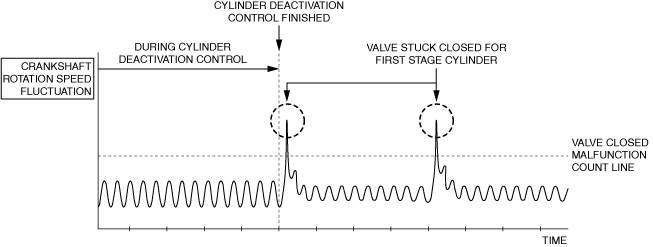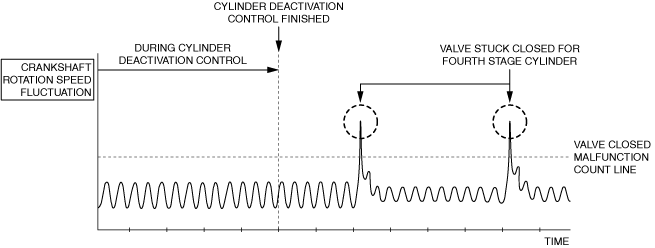DTC P3498:00 OR P349B:00 [PCM (SKYACTIV-G)]
DTC P3498:00 OR P349B:00 [PCM (SKYACTIV-G)]
SM2334489
id0102t4500400
-
Note
-
• To determine the malfunctioning part, proceed with the diagnostics from “Function Inspection Using M-MDS”.
Details On DTCs
|
Description |
Cylinder deactivation control system: • P3498:00: No.1 cylinder valve is stuck closed
• P349B:00: No.4 cylinder valve is stuck closed
|
|
|---|---|---|
|
Detection condition
|
Determination conditions
|
• The crankshaft fluctuation rate exceeds the specified value for every 200 rotations of the crankshaft after recovery from cylinder deactivation control.
|
|
Preconditions
|
• Battery voltage: 9—18 V *1
• Engine speed: 500—6,500 rpm *1
• Engine coolant temperature: 20 °C {68 °F} or more *1
• Fuel-cut control not implemented
• Crankshaft installation tolerance learning completed
• Engine condition is stabilized (not directly after gear change)
*1: Standard can be verified by displaying PIDs using M-MDS
|
|
|
Malfunction determination period
|
• 200 rotations of crankshaft (misfire which may damage catalytic converter)
|
|
|
Drive cycle
|
• 1
|
|
|
Self test type
|
• CMDTC self test
|
|
|
Sensor used
|
• CKP sensor
• MAF sensor
• MAP sensor
|
|
|
Fail-safe function
|
• Limits intake air amount
• Implement fuel-cut control (If cylinder is filled with fuel when valve is stuck closed, fuel-cut on No.1 or No.4 cylinder is performed because engine could be damaged at compression stroke).
|
|
|
Vehicle status when DTCs are output
|
• Possibility of engine damage occurring.
• Rough idling, poor acceleration, stalling
|
|
|
Possible cause
|
• Improper operation of ignition system
• Fuel injector malfunction
• OCV for No.1 cylinder deactivation malfunction
• OCV for No.4 cylinder deactivation malfunction
• Switchable HLA malfunction
• Engine oil solenoid valve malfunction
• Erratic signal to PCM
• Air leakage from intake air system (between intake manifold and cylinder head)
• Poor drive belt assembly or adhesion of oil
• Decoupling ring tensioner malfunction (With Mazda M Hybrid)
• Drive belt auto tensioner malfunction (Without Mazda M Hybrid)
• Engine malfunction
• PCM malfunction
|
|
System Wiring Diagram
Function Explanation (DTC Detection Outline)
P3498:00
am3zzw00033566
|
P349B:00
am3zzw00033567
|
Repeatability Verification Procedure
PID Item/Simulation Item Used In Diagnosis
PID/DATA monitor item table
|
PIDs |
Reference |
|---|---|
|
APP1
|
|
|
APP2
|
|
|
ECT
|
|
|
ECT_VOLT
|
|
|
IAT
|
|
|
MAF
|
|
|
MAP
|
|
|
MAP_VOLT
|
|
|
ENG_RPM
|
|
|
TP_RELAT
|
|
|
VSS
|
Function Inspection Using M-MDS
|
STEP |
INSPECTION |
RESULTS |
ACTION |
|---|---|---|---|
|
1
|
PURPOSE: VERIFY RELATED REPAIR INFORMATION OR SERVICE INFORMATION AVAILABILITY
• Verify related Service Bulletins, on-line repair information, or Service Information availability.
• Is any related Information available?
|
Yes
|
Perform repair or diagnosis according to the available information.
• If the vehicle is not repaired, go to the next step.
|
|
No
|
Go to the next step.
|
||
|
2
|
PURPOSE: IDENTIFY TRIGGER DTC FOR FREEZE FRAME DATA
• Is the DTC P3498:00 or P349B:00 on freeze frame data?
|
Yes
|
Go to the next step.
|
|
No
|
Go to the troubleshooting procedure for DTC on freeze frame data.
|
||
|
3
|
PURPOSE: RECORD VEHICLE STATUS WHEN DTC WAS DETECTED TO UTILIZE WITH REPEATABILITY VERIFICATION
• Record the freeze frame data/snapshot data.
|
—
|
Go to the next step.
|
|
4
|
PURPOSE: INSPECT FOR OTHER RELATED DTCs
• Perform the DTC inspection for the PCM. (See DTC INSPECTION.)
• Are any other DTCs displayed?
|
Yes
|
Repair the malfunctioning location according to the applicable DTC troubleshooting.
|
|
No
|
Go to the next step.
|
||
|
5
|
PURPOSE: VERIFY IF THERE IS PID ITEM CAUSING DRASTIC CHANGES OF ACCELERATION FLUCTUATION BY INPUT SIGNAL TO PCM
• Start the engine.
• Access the following PIDs using the M-MDS: (See PID/DATA MONITOR INSPECTION.)
• Is there a PID item affected by acceleration fluctuation?
|
Yes
|
Inspect the suspected sensor and related wiring harness.
• If there is any malfunction:
• If there is no malfunction:
|
|
No
|
Go to the next step.
|
Troubleshooting Diagnostic Procedure
-
― Perform an ignition system parts inspection.
-
― Perform an engine oil related inspection.
-
― Perform a fuel injector control system inspection.
-
― Perform an inspection of parts which may be affected by misfire except for ignition-related parts and fuel injection control-related parts.
-
― Verify that primary malfunction is resolved and there are no other malfunctions.
|
STEP |
INSPECTION |
RESULTS |
ACTION |
|---|---|---|---|
|
1
|
PURPOSE: INSPECT SPARK PLUG FOR MALFUNCTION
• Inspect the applicable part. (See SPARK PLUG INSPECTION [SKYACTIV-G (WITH CYLINDER DEACTIVATION (US))].)
• Is the part normal?
|
Yes
|
Go to the next step.
|
|
No
|
Repair or replace the malfunctioning location and perform the repair completion verification.
|
||
|
2
|
PURPOSE: INSPECT IGNITION COIL FOR MALFUNCTION
• Inspect the applicable part. (See IGNITION COIL INSPECTION [SKYACTIV-G (WITH CYLINDER DEACTIVATION (US))].)
• Is the part normal?
|
Yes
|
Go to the next step.
|
|
No
|
Repair or replace the malfunctioning location and perform the repair completion verification.
|
||
|
3
|
PURPOSE: INSPECT OCV FOR No.1 CYLINDER DEACTIVATION FOR MALFUNCTION
• Inspect the applicable part. (See OIL CONTROL VALVE (OCV) FOR CYLINDER DEACTIVATION INSPECTION [SKYACTIV-G (WITH CYLINDER DEACTIVATION (US))].)
• Is the part normal?
|
Yes
|
Go to the next step.
|
|
No
|
Repair or replace the malfunctioning location and perform the repair completion verification.
|
||
|
4
|
PURPOSE: INSPECT OCV FOR No.4 CYLINDER DEACTIVATION FOR MALFUNCTION
• Inspect the applicable part. (See OIL CONTROL VALVE (OCV) FOR CYLINDER DEACTIVATION INSPECTION [SKYACTIV-G (WITH CYLINDER DEACTIVATION (US))].)
• Is the part normal?
|
Yes
|
Go to the next step.
|
|
No
|
Repair or replace the malfunctioning location and perform the repair completion verification.
|
||
|
5
|
PURPOSE: INSPECT SWITCHABLE HLA FOR MALFUNCTION
• Inspect the applicable part. (See HYDRAULIC LASH ADJUSTER (HLA) INSPECTION [SKYACTIV-G (WITH CYLINDER DEACTIVATION (US))].)
• Is the part normal?
|
Yes
|
Go to the next step.
|
|
No
|
Repair or replace the malfunctioning location and perform the repair completion verification.
|
||
|
6
|
PURPOSE: INSPECT ENGINE OIL SOLENOID VALVE FOR MALFUNCTION
• Inspect the applicable part. (See ENGINE OIL SOLENOID VALVE INSPECTION [SKYACTIV-G (WITH CYLINDER DEACTIVATION (US))].)
• Is the part normal?
|
Yes
|
Go to the next step.
|
|
No
|
Repair or replace the malfunctioning location and perform the repair completion verification.
|
||
|
7
|
PURPOSE: INSPECT FUEL INJECTOR FOR MALFUNCTION
• Inspect the applicable part. (See FUEL INJECTOR INSPECTION [SKYACTIV-G (WITH CYLINDER DEACTIVATION (US))].)
• Is the part normal?
|
Yes
|
Go to the next step.
|
|
No
|
Repair or replace the malfunctioning location and perform the repair completion verification.
|
||
|
8
|
PURPOSE: VERIFY IF MALFUNCTION RELATED TO INTAKE-AIR SYSTEM IS CAUSE OF VALVE BEING STUCK CLOSED
• Visually inspect for loose, cracked or damaged hoses on intake air system.
• Is there any malfunction?
|
Yes
|
Repair or replace the malfunctioning location and perform the repair completion verification.
|
|
No
|
Go to the next step.
|
||
|
9
|
PURPOSE: VERIFY IF POOR DRIVE BELT ASSEMBLY IS CAUSE OF VALVE BEING STUCK CLOSED
• Verify the condition of the drive belt assembly. (See DRIVE BELT INSPECTION [SKYACTIV-G (WITH CYLINDER DEACTIVATION (US))].)
• Is there any malfunction?
|
Yes
|
Assemble drive belt correctly and perform the repair completion verification.
|
|
No
|
Go to the next step.
|
||
|
10
|
PURPOSE: VERIFY IF FOREIGN MATTER ON DRIVE BELT IS CAUSE OF VALVE BEING STUCK CLOSED
• Verify if oil is on the drive belt.
• Is there foreign matter on the drive belt?
|
Yes
|
Remove the foreign matter on the drive belt and perform the repair completion verification.
|
|
No
|
Vehicles with Mazda M Hybrid:
• Go to the next step.
Vehicles without Mazda M Hybrid:
• Go to Step 12.
|
||
|
11
|
PURPOSE: INSPECT DECOUPLING RING TENSIONER FOR MALFUNCTION
• Inspect the applicable part.
• Is the part normal?
|
Yes
|
Go to the next step.
|
|
No
|
Repair or replace the malfunctioning location and perform the repair completion verification.
|
||
|
12
|
PURPOSE: INSPECT DRIVE BELT AUTO TENSIONER FOR MALFUNCTION
• Inspect the applicable part. (See DRIVE BELT AUTO TENSIONER INSPECTION [SKYACTIV-G (WITH CYLINDER DEACTIVATION (US))].)
• Is the part normal?
|
Yes
|
Go to the next step.
|
|
No
|
Repair or replace the malfunctioning location and perform the repair completion verification.
|
||
|
13
|
PURPOSE: VERIFY IF MALFUNCTION RELATED TO ENGINE COMPRESSION IS CAUSE OF VALVE BEING STUCK CLOSED
• Inspect the engine compression. (See COMPRESSION INSPECTION [SKYACTIV-G (WITH CYLINDER DEACTIVATION (US))].)
• Are compression pressures within specification?
|
Yes
|
Go to the next step.
|
|
No
|
Replace or overhaul the engine and perform the repair completion verification.
|
||
|
14
|
PURPOSE: VERIFY IF MALFUNCTION RELATED TO SEALING OF ENGINE UNIT (COMBUSTION CHAMBER AND ENGINE COOLANT PASSAGE) IS CAUSE OF MISFIRE
• Perform the “ENGINE COOLANT LEAKAGE INSPECTION”. (See ENGINE COOLANT LEAKAGE INSPECTION [SKYACTIV-G (WITH CYLINDER DEACTIVATION (US))].)
• Does the radiator cap tester needle drop even though there is no engine coolant leakage from the radiator or the hoses?
|
Yes
|
Engine coolant leakage from the engine (between the combustion chamber and the engine coolant passage) may have occurred.
• Verify the conditions of the gasket and the cylinder head.
|
|
No
|
Go to the next step.
|
||
|
15
|
PURPOSE: INSPECT FOR MALFUNCTION DUE TO INTERNAL ENGINE WEAR, DAMAGE
• Inspect for the following engine internal parts:
• Are all items normal?
|
Yes
|
Engine internal parts are normal.
• Go to the next step.
|
|
No
|
Repair or replace the malfunctioning location and perform the repair completion verification.
|
||
|
Repair completion verification 1
|
PURPOSE: VERIFY THAT VEHICLE IS REPAIRED
• Install/connect the part removed/disconnected during the troubleshooting procedure.
• Clear the DTC recorded in the memory. (See CLEARING DTC.)
• Replicate the vehicle conditions at the time the DTC was detected using the following procedure.
• Perform the DTC inspection for the PCM. (See DTC INSPECTION.)
• Is the same Pending DTC present?
|
Yes
|
Refer to the controller area network (CAN) malfunction diagnosis flow to inspect for a CAN communication error.
If the CAN communication is normal, perform the diagnosis from Step 1.
• If the malfunction recurs, replace the PCM, then go to the next step. (See PCM REMOVAL/INSTALLATION [SKYACTIV-G (WITH CYLINDER DEACTIVATION (US))].)
|
|
No
|
Go to the next step.
|
||
|
Repair completion verification 2
|
PURPOSE: VERIFY IF OTHER DTCs DISPLAYED
• Perform the DTC inspection. (See DTC INSPECTION.)
• Are any other DTCs displayed?
|
Yes
|
Repair the malfunctioning location according to the applicable DTC troubleshooting.
|
|
No
|
DTC troubleshooting completed.
|

